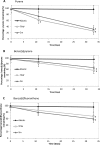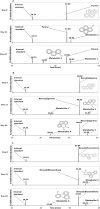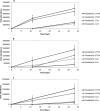Biofilm and Planktonic Bacterial and Fungal Communities Transforming High-Molecular-Weight Polycyclic Aromatic Hydrocarbons
- PMID: 26850299
- PMCID: PMC4959499
- DOI: 10.1128/AEM.03713-15
Biofilm and Planktonic Bacterial and Fungal Communities Transforming High-Molecular-Weight Polycyclic Aromatic Hydrocarbons
Abstract
High-molecular-weight polycyclic aromatic hydrocarbons (HMW-PAHs) are natural components of fossil fuels that are carcinogenic and persistent in the environment, particularly in oil sands process-affected water (OSPW). Their hydrophobicity and tendency to adsorb to organic matter result in low bioavailability and high recalcitrance to degradation. Despite the importance of microbes for environmental remediation, little is known about those involved in HMW-PAH transformations. Here, we investigated the transformation of HMW-PAHs using samples of OSPW and compared the bacterial and fungal community compositions attached to hydrophobic filters and in suspension. It was anticipated that the hydrophobic filters with sorbed HMW-PAHs would select for microbes that specialize in adhesion. Over 33 days, more pyrene was removed (75% ± 11.7%) than the five-ring PAHs benzo[a]pyrene (44% ± 13.6%) and benzo[b]fluoranthene (41% ± 12.6%). For both bacteria and fungi, the addition of PAHs led to a shift in community composition, but thereafter the major factor determining the fungal community composition was whether it was in the planktonic phase or attached to filters. In contrast, the major determinant of the bacterial community composition was the nature of the PAH serving as the carbon source. The main bacteria enriched by HMW-PAHs were Pseudomonas, Bacillus, and Microbacterium species. This report demonstrates that OSPW harbors microbial communities with the capacity to transform HMW-PAHs. Furthermore, the provision of suitable surfaces that encourage PAH sorption and microbial adhesion select for different fungal and bacterial species with the potential for HMW-PAH degradation.
Copyright © 2016 Folwell et al.
Figures






Similar articles
-
Initial characterization of new bacteria degrading high-molecular weight polycyclic aromatic hydrocarbons isolated from a 2-year enrichment in a two-liquid-phase culture system.J Appl Microbiol. 2003;94(2):301-11. doi: 10.1046/j.1365-2672.2003.01835.x. J Appl Microbiol. 2003. PMID: 12534823
-
Enhanced degradation of a mixture of polycyclic aromatic hydrocarbons by a defined microbial consortium in a two-phase partitioning bioreactor.Biodegradation. 2007 Apr;18(2):211-21. doi: 10.1007/s10532-006-9056-8. Epub 2006 Jun 7. Biodegradation. 2007. PMID: 16758271
-
Biodegradation of aged polycyclic aromatic hydrocarbons (PAHs) by microbial consortia in soil and slurry phases.J Hazard Mater. 2008 Jan 15;150(1):21-6. doi: 10.1016/j.jhazmat.2007.04.040. Epub 2007 Apr 20. J Hazard Mater. 2008. PMID: 17512657
-
A comprehensive review of metabolic and genomic aspects of PAH-degradation.Arch Microbiol. 2020 Oct;202(8):2033-2058. doi: 10.1007/s00203-020-01929-5. Epub 2020 Jun 6. Arch Microbiol. 2020. PMID: 32506150 Review.
-
Unraveling the Role of Microbes in Remediation of High Molecular Weight Polycyclic Aromatic Hydrocarbon Persistence in the Environment.Appl Biochem Biotechnol. 2025 Jul;197(7):4263-4286. doi: 10.1007/s12010-025-05245-w. Epub 2025 May 3. Appl Biochem Biotechnol. 2025. PMID: 40317443 Free PMC article. Review.
Cited by
-
Differential protein expression during growth on model and commercial mixtures of naphthenic acids in Pseudomonas fluorescens Pf-5.Microbiologyopen. 2021 Aug;10(4):e1196. doi: 10.1002/mbo3.1196. Microbiologyopen. 2021. PMID: 34459546 Free PMC article.
-
Biofilm mediated synergistic degradation of hexadecane by a naturally formed community comprising Aspergillus flavus complex and Bacillus cereus group.BMC Microbiol. 2019 Apr 29;19(1):84. doi: 10.1186/s12866-019-1460-4. BMC Microbiol. 2019. PMID: 31035915 Free PMC article.
-
Different Types of Diatom-Derived Extracellular Polymeric Substances Drive Changes in Heterotrophic Bacterial Communities from Intertidal Sediments.Front Microbiol. 2017 Feb 27;8:245. doi: 10.3389/fmicb.2017.00245. eCollection 2017. Front Microbiol. 2017. PMID: 28289404 Free PMC article.
-
Fluoranthene degradation and binding mechanism study based on the active-site structure of ring-hydroxylating dioxygenase in Microbacterium paraoxydans JPM1.Environ Sci Pollut Res Int. 2017 Jan;24(1):363-371. doi: 10.1007/s11356-016-7809-4. Epub 2016 Oct 8. Environ Sci Pollut Res Int. 2017. PMID: 27722881
-
Diamondoids are not forever: microbial biotransformation of diamondoid carboxylic acids.Microb Biotechnol. 2020 Mar;13(2):495-508. doi: 10.1111/1751-7915.13500. Epub 2019 Nov 12. Microb Biotechnol. 2020. PMID: 31714688 Free PMC article.
References
-
- European Union Water Framework Directive. 2008. Priority substances and certain other pollutants. http://ec.europa.eu/environment/water/water-framework/priority_substance....
-
- Timoney KP, Lee P. 2009. Does the Alberta tar sands industry pollute? The scientific evidence. Open Conser Biol J 3:65–81. doi: 10.2174/1874839200903010065. - DOI
Publication types
MeSH terms
Substances
LinkOut - more resources
Full Text Sources
Other Literature Sources
Medical

